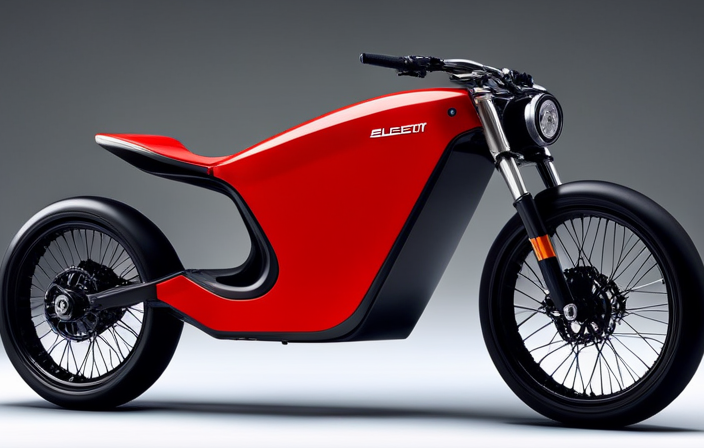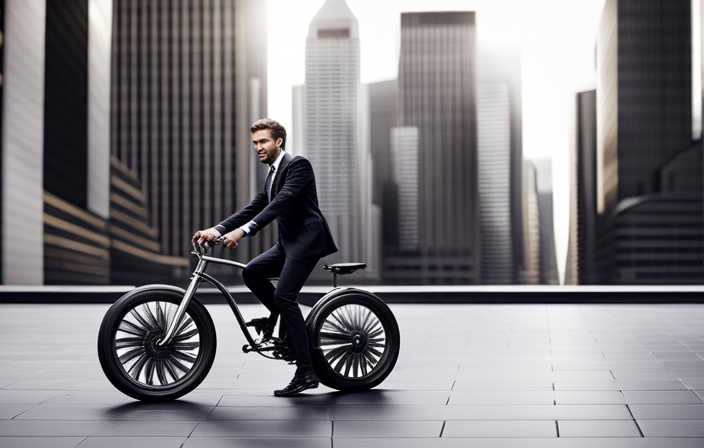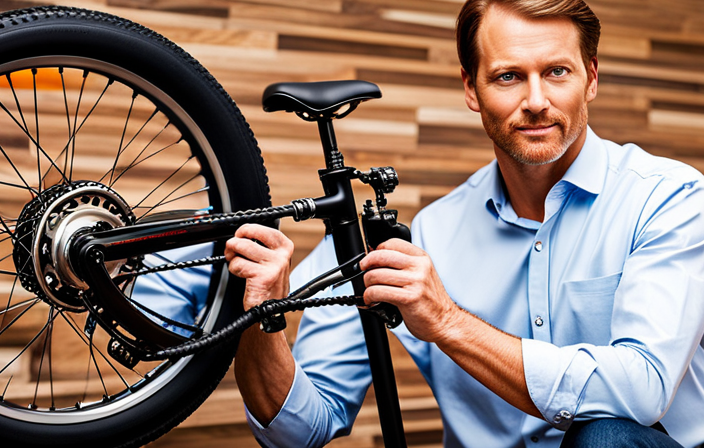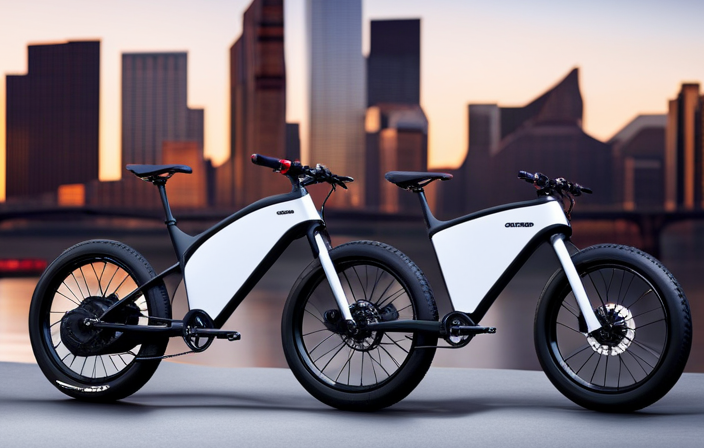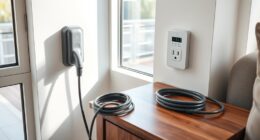As a passionate rider, I am always on the lookout for innovative and exciting ways to navigate challenging terrains. That’s why I’m thrilled to delve into the world of electric trials bikes and explore how they work.
These cutting-edge machines are powered by an electric motor that seamlessly converts electrical energy into mechanical power. With a rechargeable battery pack, precise controller, and regenerative braking, these bikes offer instant torque, minimal noise, and zero emissions.
So, let’s dive in and uncover the inner workings of these remarkable two-wheeled wonders.
Key Takeaways
- The electric trials bike consists of components such as an electric motor, battery pack, controller, and throttle, which work together to convert electrical energy into mechanical energy and control the speed and power output.
- The bike offers environmental benefits by producing zero emissions and reducing carbon footprint, as well as providing quiet operation, making it suitable for urban and residential areas.
- The electric trials bike provides advantages and convenience through low maintenance requirements, instant torque for quick acceleration, and an efficient charging system for easy and effective charging.
- The bike’s performance and technical features include a suspension system, specialized wheels and tires, single-speed transmission, battery capacity, range, and instant torque, all contributing to a versatile and enhanced riding experience.
Electric Motor: The heart of an electric trials bike, the motor converts electrical energy into mechanical energy to power the bike.
You’re probably wondering how the electric motor in an electric trials bike actually works, right? Well, let me explain.
The electric motor is the heart of the bike, responsible for converting electrical energy into mechanical energy to power the bike. One important aspect of the motor is its efficiency. Electric motor efficiency refers to how effectively it converts electrical energy into mechanical energy. Higher efficiency means less energy is wasted, resulting in better overall performance.
Another crucial factor is the motor torque characteristics. Torque is the rotational force that makes the bike move. The torque characteristics of the motor determine how the power is delivered to the wheels, affecting the bike’s acceleration and control.
Understanding these aspects is crucial for designing an electric trials bike with optimal performance.
Now, let’s move on to the battery pack: this provides the necessary electricity to the motor and is typically rechargeable. It stores and releases energy as needed.
Battery Pack: This provides the necessary electricity to the motor and is typically rechargeable. It stores and releases energy as needed.
The battery pack powers the motor and can be recharged when needed. In electric trials bikes, battery technology plays a crucial role in providing a reliable and efficient power source. These bikes are equipped with advanced lithium-ion batteries that offer several advantages over traditional lead-acid batteries.
| Advantages of Electric Trials Bikes |
|---|
| Eco-friendly |
| Low maintenance |
| Instant torque |
| Quiet operation |
Electric trials bikes are eco-friendly, producing zero emissions and reducing our carbon footprint. They require minimal maintenance compared to their gasoline counterparts. With instant torque delivery, these bikes offer quick acceleration and enhanced maneuverability. Additionally, the quiet operation of electric bikes eliminates noise pollution and allows riders to enjoy their surroundings without disturbance.
The battery pack is an essential component of an electric trials bike, providing the necessary power to the motor. However, the controller regulates the flow of electricity from the battery to the motor, controlling the bike’s speed and power output.
Controller: The controller regulates the flow of electricity from the battery to the motor, controlling the bike’s speed and power output.
The controller is responsible for managing the flow of electricity, determining how fast the motor operates, and how much power is generated. It acts as the brain of the electric trials bike, ensuring smooth and efficient operation.
Here are three key functions of the electric trials bike controller:
-
Speed Control: The controller receives input from the throttle and adjusts the power sent to the motor accordingly. This allows the rider to control the speed of the bike with precision.
-
Power Regulation: The controller monitors the power output of the battery and ensures that it is delivered in a controlled and safe manner. It prevents overloading and protects the battery from damage.
-
Safety Features: The controller incorporates various safety features such as overheat protection, short circuit detection, and emergency shutdown. These features help to prevent accidents and protect the rider and the bike.
Transitioning to the subsequent section about the throttle:
The throttle is used to control the speed of the bike. It adjusts the amount of power sent to the motor based on the rider’s input.
Throttle: The throttle is used to control the speed of the bike. It adjusts the amount of power sent to the motor based on the rider’s input.
To control the speed of your bike, simply adjust the throttle to increase or decrease the power sent to the motor. Throttle control is a vital component of power management in electric trials bikes.
By manipulating the throttle, riders can fine-tune the amount of power delivered to the motor, allowing for precise control over acceleration and speed. The throttle responds to the rider’s input, providing a seamless connection between the rider and the bike’s performance.
Electric trials bikes often feature regenerative braking, which converts kinetic energy back into electrical energy, recharging the battery while braking. This innovative feature not only enhances the bike’s efficiency but also extends the battery life, allowing riders to enjoy longer and more exhilarating rides.
Regenerative Braking: Electric trials bikes often feature regenerative braking, which converts kinetic energy back into electrical energy, recharging the battery while braking.
By converting kinetic energy back into electrical energy, regenerative braking in electric trials bikes helps recharge the battery while braking. This technology has revolutionized the way electric trials bikes are used and has opened up new applications for these bikes.
Here are some advancements in regenerative braking technology:
-
Increased Efficiency: Modern electric trials bikes are equipped with advanced regenerative braking systems that can capture a higher percentage of the kinetic energy and convert it into electrical energy, resulting in improved battery recharge rates.
-
Extended Range: With regenerative braking, riders can go further on a single charge as the energy that would have been lost during braking is now being stored back into the battery.
-
Enhanced Control: Regenerative braking systems in electric trials bikes provide riders with more control over their speed and braking, allowing for greater precision and maneuverability on challenging terrains.
Transition: Now that we have explored the regenerative braking technology in electric trials bikes, let’s move on to discussing the bike’s frame and suspension system, which play a crucial role in providing stability, control, and support for navigating those challenging terrains.
Frame and Suspension: The bike’s frame and suspension system provide stability, control, and support for navigating challenging terrains.
When navigating challenging terrains, I rely on the stability, control, and support of the frame and suspension system.
The frame of an electric trials bike is designed to be strong and lightweight, providing a solid foundation for the rider. This ensures that the bike can withstand the demands of off-road riding while maintaining stability.
The suspension system plays a vital role in absorbing shocks and vibrations, allowing the bike to maintain traction and control. The suspension design is optimized to adapt to varying terrain conditions, ensuring that the bike’s center of gravity remains balanced for better maneuverability.
As we transition into discussing wheels and tires, it is important to note that specially designed wheels and tires provide traction and stability, allowing the bike to maneuver over various terrains.
Wheels and Tires: Specially designed wheels and tires provide traction and stability, allowing the bike to maneuver over various terrains.
You’ll notice that specially designed wheels and tires on your electric trials bike allow for excellent traction and stability, enabling you to maneuver smoothly over various terrains.
The tire grip is enhanced through the use of specialized compounds that provide optimal traction on different surfaces. The unique tread pattern on the tires further improves grip by channeling water, mud, and other debris away from the contact patch.
Additionally, the wide profile of the tires increases the bike’s stability, allowing for better control during challenging maneuvers. The adaptability of the wheels and tires ensures that your electric trials bike can handle anything from rocky trails to slippery surfaces with ease.
This combination of tire grip and terrain adaptability makes electric trials bikes the perfect choice for off-road enthusiasts.
Speaking of off-road performance, let’s transition into the next section about the transmission.
Transmission: Electric trials bikes typically have a single-speed transmission, eliminating the need for shifting gears.
The single-speed transmission on electric trials bikes eliminates the need for gear shifting. This provides several advantages in terms of simplifying the rider’s experience and improving performance. With a single-speed transmission, there are no gears to shift, allowing riders to focus solely on their technique and maneuverability. This simplicity also reduces the risk of mechanical failures and makes maintenance easier.
Furthermore, the absence of gear shifting results in a smoother power delivery, allowing riders to have better control over acceleration and torque. Overall, the single-speed transmission enhances the overall riding experience by providing a seamless and efficient power transfer.
Transitioning from the transmission to the charging system, electric trials bikes come equipped with a charging system that allows the battery to be easily plugged into a power source for recharging.
Charging System: To recharge the battery, electric trials bikes come with a charging system that allows the battery to be plugged into a power source.
To recharge the battery, electric trials bikes come equipped with a charging system that allows riders to easily plug the battery into a power source. This charging system is an essential part of the electric trials bike charging technology, providing several benefits to riders.
Convenience: The charging system allows riders to charge their bikes at home or any other power outlet, eliminating the need for specialized charging stations.
Efficiency: Electric trials bike charging systems are designed to be highly efficient, ensuring that the battery is charged quickly and effectively.
Versatility: With the charging system, riders have the flexibility to charge their bikes whenever and wherever they need, allowing for uninterrupted riding experiences.
The electric trials bike charging system plays a crucial role in maximizing the performance and usability of the bike. It ensures that riders can easily recharge their bikes, enabling them to enjoy longer rides and explore various terrains without worrying about running out of battery power.
Transitioning into the subsequent section about the range of an electric trials bike, it is important to understand that factors such as battery capacity and riding conditions significantly impact the bike’s range.
Range: The range of an electric trials bike refers to the distance it can travel on a single charge. Factors such as battery capacity and riding conditions affect the range.
When it comes to electric trials bikes, one of the crucial factors to consider is the range. The range refers to the distance the bike can travel on a single charge. It is influenced by two main factors: battery capacity and riding conditions.
Battery capacity determines how much energy the battery can store, therefore affecting the overall range. A higher battery capacity will allow for a longer distance to be covered before needing a recharge.
Riding conditions also play a significant role. Factors such as terrain, rider weight, and riding style can impact the bike’s energy consumption and, consequently, the range. It’s important to take these factors into account when planning your rides to ensure you don’t run out of power.
Now, let’s move on to the next section, where we will explore how the weight distribution of an electric trials bike is carefully designed to optimize handling and performance.
Weight Distribution: The placement of the battery and other components is carefully designed to optimize weight distribution for better handling and performance.
Optimizing weight distribution on an electric trials bike is crucial for improving handling and performance. The placement of the battery and other components is carefully designed to achieve optimal weight distribution. Here are three key reasons why weight distribution optimization is essential:
-
Enhanced Stability: Proper weight distribution ensures that the bike remains stable during maneuvers, making it easier to maintain control and balance.
-
Improved Maneuverability: By distributing the weight evenly, you can navigate tight turns and obstacles with greater precision and ease.
-
Increased Responsiveness: A well-balanced bike allows for quicker and more precise steering inputs, resulting in improved responsiveness and agility.
With weight distribution optimized, you can confidently tackle challenging terrain and push your limits on an electric trials bike.
This leads us to the next crucial aspect of electric trials riding: torque. Electric motors provide instant torque, which is beneficial for trials riding, where quick acceleration and maneuverability are essential.
Torque: Electric motors provide instant torque, which is beneficial for trials riding, where quick acceleration and maneuverability are essential.
With instant torque provided by electric motors, you can accelerate quickly and maneuver with ease on a trials ride. Electric trials bikes excel in delivering quick acceleration, allowing riders to swiftly navigate through challenging terrain.
The electric motor’s instantaneous torque output ensures that power is instantly available when needed, enabling the bike to rapidly accelerate from a standstill or overcome obstacles with ease. This quick acceleration is crucial for trials riding, where precision and speed are paramount.
Maneuverability is another key advantage of electric trials bikes. The compact size and lightweight nature of these bikes, coupled with their precise handling characteristics, make it effortless to navigate tight corners and tricky sections. This combination of rapid acceleration and exceptional maneuverability gives riders a significant edge on the trials course.
Speaking of advantages, electric trials bikes are known for their quiet operation, as they produce minimal noise compared to traditional combustion engines. This attribute not only reduces noise pollution but also allows riders to enjoy a serene riding experience in natural environments. The absence of engine noise can also be advantageous in competitions, as it helps riders focus better on their technique and improve their performance.
Noise Levels: Electric trials bikes are known for their quiet operation, as they produce minimal noise compared to traditional combustion engines.
Electric trials bikes are praised for their low noise levels, providing riders with a peaceful and serene riding experience. Unlike traditional combustion engines, electric trials bikes produce minimal noise pollution, making them ideal for environmentally-conscious riders. The quiet operation of these bikes not only reduces noise pollution but also minimizes the ecological impact associated with motorized vehicles.
By eliminating the loud revving and engine noises, electric trials bikes contribute to a more harmonious coexistence with nature. This is particularly important in off-road riding environments, where tranquility and the preservation of natural habitats are paramount. Moreover, the reduced noise levels allow riders to focus more on their technique and concentration, enhancing their overall performance.
Maintenance:
Electric trials bikes generally require less maintenance compared to gas-powered bikes, as they have fewer moving parts and no need for oil changes or spark plug replacements.
Maintenance: Electric trials bikes generally require less maintenance compared to gas-powered bikes, as they have fewer moving parts and no need for oil changes or spark plug replacements.
Transition: Now that we’ve explored the quiet operation of electric trials bikes, let’s dive into their low maintenance requirements and the advantages they offer.
Current Subtopic: Maintenance: Electric trials bikes are known for their minimal maintenance needs, making them a convenient choice for riders. Here are some key advantages and maintenance tips to keep in mind:
- Fewer moving parts: Electric trials bikes have a simpler design with fewer components, reducing the chances of mechanical failures and the need for frequent repairs.
- No oil changes: Unlike gas-powered bikes, electric trials bikes do not require oil changes, saving time and money on oil purchases.
- No spark plug replacements: Since electric trials bikes don’t have combustion engines, there is no need to replace spark plugs, eliminating another maintenance task.
- Regular battery maintenance: To ensure optimal performance, it is important to regularly check and maintain the battery of an electric trials bike, including proper charging and storage.
Transition: Now that we’ve covered the advantages and maintenance tips, let’s move on to discussing the environmental benefits of electric trials bikes and how they contribute to reducing carbon footprint and environmental impact.
Environmental Benefits: Electric trials bikes produce zero emissions, reducing the carbon footprint and environmental impact associated with traditional combustion engines
When it comes to environmental benefits, you’ll be pleased to know that electric trials bikes emit zero emissions, making them an eco-friendly choice. This means that they do not contribute to air pollution, reducing the carbon footprint and environmental impact associated with traditional combustion engines.
By opting for electric trials bikes, not only are you choosing sustainable transportation, but you are also actively working towards reducing air pollution and creating a cleaner and healthier environment. These bikes are powered by electricity, which is a renewable energy source. This makes them a more sustainable alternative to gas-powered bikes, as they do not rely on fossil fuels that contribute to greenhouse gas emissions.
Frequently Asked Questions
How long does it take to fully charge the battery of an electric trials bike?
The charging time of an electric trials bike’s battery depends on its capacity. Typically, it takes around 2-4 hours to fully charge the battery. However, factors like the charger’s power output and battery condition can affect the charging time.
Can I use a regular power outlet to charge my electric trials bike?
Yes, you can use a regular power outlet to charge your electric trials bike. The charging time will depend on the specific model and battery capacity. Ensure the outlet has the necessary voltage and amperage for compatibility.
Are there any specific safety precautions to consider when riding an electric trials bike?
When riding an electric trials bike, it is crucial to prioritize safety. Always wear proper safety gear, such as a helmet, goggles, and protective clothing. Additionally, regular maintenance checks and following manufacturer guidelines can help ensure a safe and enjoyable riding experience.
Can the battery be easily replaced or upgraded in an electric trials bike?
Yes, the battery can be easily replaced or upgraded in an electric trials bike. However, it is important to consider the battery lifespan and performance, as these factors can affect the overall performance of the bike.
Are there any limitations to riding an electric trials bike in terms of terrain or weather conditions?
There are limitations to riding an electric trials bike, especially in challenging terrains. The bike’s performance can be affected by weather conditions such as rain or snow, making it less efficient and potentially unsafe.
Conclusion
In conclusion, electric trials bikes are revolutionizing the world of off-road riding. These bikes provide instant torque and impressive maneuverability, thanks to their powerful electric motors and rechargeable battery packs. They offer a quieter and low-maintenance alternative to traditional combustion engines. Additionally, electric trials bikes help in reducing carbon emissions, aligning with the saying "go green, ride clean." By embracing the future and experiencing the thrill of trials riding, riders can make a positive impact on the environment.
